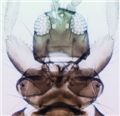Dactuliothrips xerophilus
Recognition data
Distinguishing features
Female fully winged. Body, legs and antennae brown, except fore tarsi, fore tibiae and antennal segment III and sometimes IV yellow; forewings shaded distally but pale near base. Antennae 9-segmented, segment IX longer than VIII; segment III apparently without sensoria, IV with 1 small oval sensorium. Head relatively long with two pairs of long postocular setae. Pronotum with many prominent setae, about five pairs on anterior margin and five pairs on posterior margin. Mesonotum with many microtrichia. Metanotum with only one pair of setae, sculpture arcuate around anterior margin and with many microtrichia. Fore femur with one to four small moderately stout setae on inner margin. Fore tarsal hamus recurved. Forewing broad with apex rounded. Abdominal tergites with transverse lines of sculpture. Sternites IV � VI with three pairs of marginal setae and five to six discal setae medially but not laterally, completely covered with microtrichia; sternite VII with discal setae laterally and two pairs of supernumerary setae sub-medially.
Related and similar species
Currently there are six species described in the genus Dactuliothrips; four are from California and two from Argentina.
Taxonomic data
Current valid name
Dactuliothrips xerophilus Bailey
Original name and synonyms
Dactuliothrips xerophilus Bailey, 1937:122
Family placement
Aeolothripidae
Biological data
Life history
Presumably breeding in flowers.
Host plants
Yucca brevifolia (Agavaceae).
Tospoviruses vectored
None
Crop damage
None
Distribution data
Area of origin
Western USA
Distribution
California








